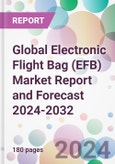According to the report, the global electronic flight bag (EFB) market reached a value of USD 2.7 billion in 2023. Aided by the rapid digitisation in the aviation sector and the growing emphasis on reducing the weight of on-board flight documentation, the market is projected to further grow at a CAGR of 8.40% between 2024 and 2032.
Electronic Flight Bags (EFBs) represent the digital evolution of traditional pilot briefcases, which once contained stacks of manuals, charts, and other vital documentation. Today, EFBs offer a comprehensive electronic interface that allows pilots to perform various flight management tasks with greater ease and efficiency. The EFB system enhances flight safety, reduces cockpit workload, and promises environmental benefits due to reduced paper usage and weight.
The thrust towards more sustainable and efficient aviation practices is significantly advancing the global electronic flight bag (EFB) market growth. With airlines keen on reducing fuel consumption, the elimination of heavy flight bags and subsequent weight savings can lead to notable fuel economies. Furthermore, the instantaneous update capability of EFBs ensures pilots have access to the latest flight-related data, a crucial aspect in the ever-evolving dynamics of air travel.
EFBs are also experiencing a surge in demand due to the increasing integration of advanced technologies in the aviation sector. Integration with real-time data, weather forecasting systems, and advanced navigation systems amplifies the electronic flight bag (EFB) market demand. Moreover, the push towards smart cockpits and the rise in the usage of Artificial Intelligence (AI) and Machine Learning (ML) in aviation further underscore the importance of sophisticated EFB systems.
Additionally, the global EFB market is also benefiting from regulatory tailwinds. Aviation authorities worldwide are increasingly recognising the value EFBs bring to flight safety and efficiency. As a result, there has been a concerted push towards establishing robust frameworks that enable the broader adoption of EFBs across commercial, cargo, and even private flight operations.
According to the electronic flight bag (EFB) market analysis, in the face of these advancements, EFB manufacturers are not resting on their laurels. The market is witnessing continuous R&D efforts aimed at making EFBs more user-friendly, secure, and integrated. Modern EFBs are now coming equipped with enhanced touch interfaces, superior data security protocols, and seamless connectivity options, setting the stage for the next phase of aviation digitisation.
Electronic Flight Bags (EFBs) represent the digital evolution of traditional pilot briefcases, which once contained stacks of manuals, charts, and other vital documentation. Today, EFBs offer a comprehensive electronic interface that allows pilots to perform various flight management tasks with greater ease and efficiency. The EFB system enhances flight safety, reduces cockpit workload, and promises environmental benefits due to reduced paper usage and weight.
The thrust towards more sustainable and efficient aviation practices is significantly advancing the global electronic flight bag (EFB) market growth. With airlines keen on reducing fuel consumption, the elimination of heavy flight bags and subsequent weight savings can lead to notable fuel economies. Furthermore, the instantaneous update capability of EFBs ensures pilots have access to the latest flight-related data, a crucial aspect in the ever-evolving dynamics of air travel.
EFBs are also experiencing a surge in demand due to the increasing integration of advanced technologies in the aviation sector. Integration with real-time data, weather forecasting systems, and advanced navigation systems amplifies the electronic flight bag (EFB) market demand. Moreover, the push towards smart cockpits and the rise in the usage of Artificial Intelligence (AI) and Machine Learning (ML) in aviation further underscore the importance of sophisticated EFB systems.
Additionally, the global EFB market is also benefiting from regulatory tailwinds. Aviation authorities worldwide are increasingly recognising the value EFBs bring to flight safety and efficiency. As a result, there has been a concerted push towards establishing robust frameworks that enable the broader adoption of EFBs across commercial, cargo, and even private flight operations.
According to the electronic flight bag (EFB) market analysis, in the face of these advancements, EFB manufacturers are not resting on their laurels. The market is witnessing continuous R&D efforts aimed at making EFBs more user-friendly, secure, and integrated. Modern EFBs are now coming equipped with enhanced touch interfaces, superior data security protocols, and seamless connectivity options, setting the stage for the next phase of aviation digitisation.
Market Segmentation
The market can be divided based on type, component, application, and region.Market Breakup by Type
- Portable
- Installed
Market Breakup by Component
- Hardware
- Software
Market Breakup by Application
- Commercial
- Military
- Personal
- Others
Market Breakup by Region
- North America
- Europe
- Asia Pacific
- Latin America
- Middle East and Africa
Competitive Landscape
The report looks into the market shares, plant turnarounds, capacities, investments, and mergers and acquisitions, among other major developments, of the leading companies operating in the global electronic flight bag (EFB) market. Some of the major players explored in the report are as follows:- The Boeing Company
- Collins Aerospace
- Thales Group
- CMC Electronics Inc.
- Lufthansa Systems GmbH & Co. KG
- Others
Table of Contents
1 Preface2 Report Coverage - Key Segmentation and Scope4 Key Assumptions7 Industry Opportunities and Challenges12 Industry Events and Developments
3 Report Description
5 Executive Summary
6 Market Snapshot
8 Global Electronic Flight Bag (EFB) Market Analysis
9 Regional Analysis
10 Market Dynamics
11 Competitive Landscape
List of Key Figures and Tables
Companies Mentioned
- The Boeing Company
- Collins Aerospace
- Thales Group
- CMC Electronics Inc.
- Lufthansa Systems GmbH & Co. KG
Methodology

LOADING...







